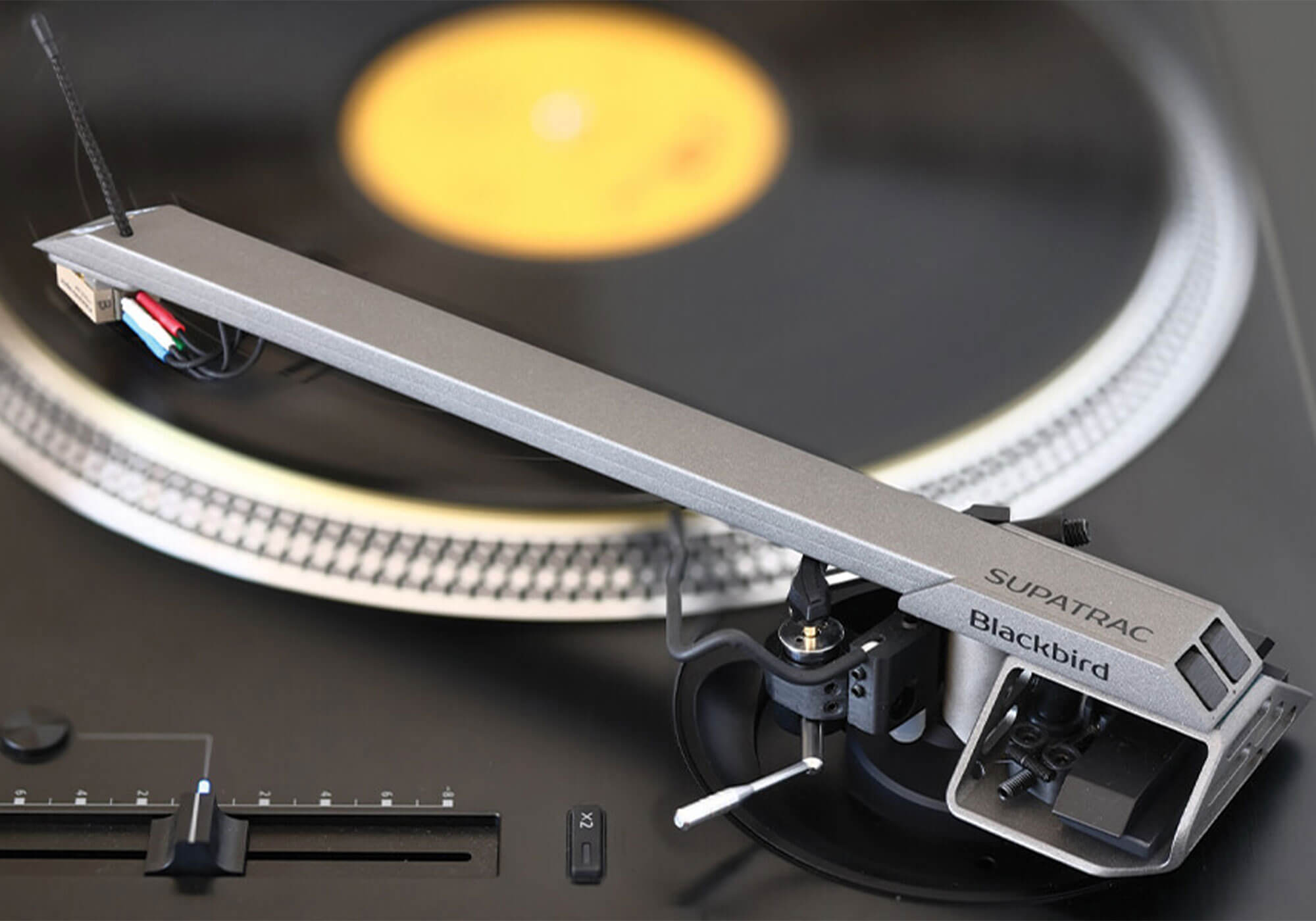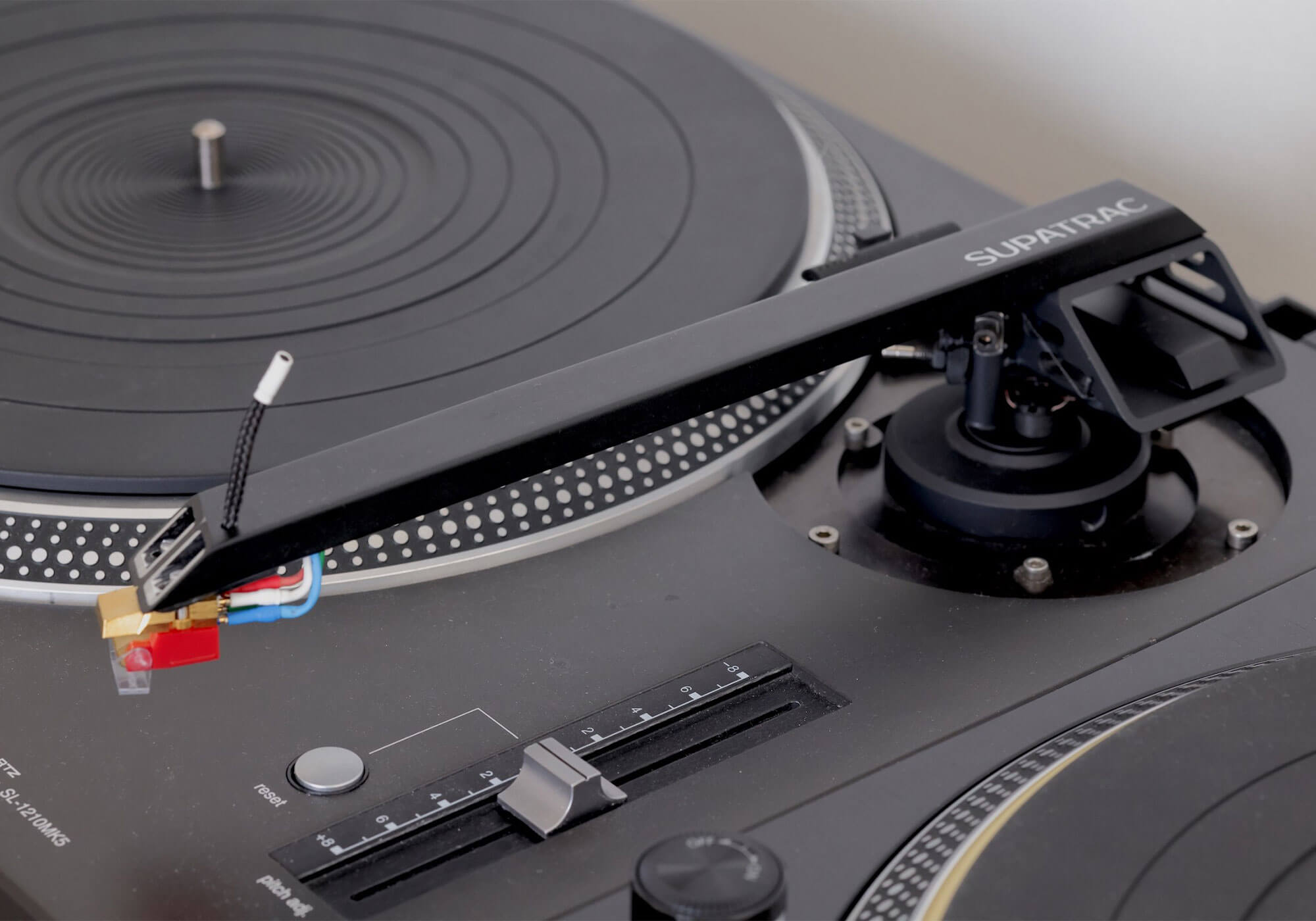SUPATRAC Blackbird & Nighthawk
During the challenging times of the Covid-19 pandemic, many people had to stay home for long periods of time. In London, Richard Braine decided to use this time to attend to something he had been thinking about but never had the time to do – build a tonearm for his turntable. Richard had a physics degree and lots of experience in problem solving and developing new ideas, especially in the software industry. He felt that the tonearms that he had used over the years had some obvious design flaws and it would be interesting to see if he could make some improvements.
This home hobby project became the birth of SUPATRAC and turned out to be one of the most important recent events in the world of analog music reproduction. You know that moment when you see something for the first time and are struck by its design elegance and simplicity? You think “Genius! Why didn’t anyone think of that before?”. This is one of those moments, a moment where you know this is going to change the landscape.
All pivoted arms have certain challenges, the main one being that as the record pulls the tonearm forward, the tonearm moves backwards and forwards across the pivot point which affects the accuracy of the sound in the time domain. The SUPATRAC arm has a patented ‘Sideways Uni-Pivot Arm’ bearing that directly opposes stylus drag at a single point of contact, eliminating microscopic play in the time axis and avoiding the scrubbing and roll movements which can degrade the performance of conventional uni-pivots and actually… all pivoted arms. Richard’s ‘SUPA’ bearing delivers unprecedented performance which gives the music a planted, solid, detailed, consistent sound. Due to its design, when the tonearm encounters a warped record, instead of being knocked out of the groove, the tonearm exerts a downward motion, keeping the stylus tracking perfectly. This tracking ability is part of the sonic magic that the SUPATRAC design delivers. It also uses a twin tube carbon fibre armwand design.
When we first heard about this design, we obtained a sample and listened to it. Within a couple of minutes, we felt that this was a major step forward in tonearm performance. Sometimes you don’t realise how a small aspect of the design may be degrading the sound till you hear the absence of that aspect. Then your mind adjusts and you realise that all those years you were hearing the result of those micro-movements in all those uni-pivot tonearms and it dawns on you that it is not a ‘small aspect of the design’… it’s a REALLY big deal!
A few weeks later, we matched a SUPATRAC Blackbird with our Helix One Mk3 turntable at a show and it was a huge success. The great disparity in the pricing of the turntable and the tonearm points to the great value the SUPATRAC arm represents. The SUPATRAC Blackbird has been labelled a ‘giant killer’ and remains an excellent choice for anyone wanting a phenomenal tonearm for the cost. In 2024, SUPATRAC released another model, the Nighthawk. Despite looking similar to the Blackbird, the Nighthawk is a very different arm and is a representation of the highest performance that is available from SUPATRAC.
Despite the annoying hype of the high-end audio press, true revelatory innovations in tonearm design only come along once in a generation. We believe that in the case of the SUPATRAC Blackbird & Nighthawk, the adulation these tonearms are receiving is worth it.
Blackbird Vs Nighthawk
Common features
- The Blackbird and Nighthawk tonearms are available in 9 inch, 9.3 inch, 10.5 inch, 12 inch or custom length versions.
- Both tonearms now include the familiar damped cueing system found on most tonearms, as well as both rigid and string finger lifts and a new arm rest platform.
- Both are medium mass arms that can be used as is with a wide variety of cartridges with varying compliances.
- A supplied sliding “Mass adapter” can increase effective mass and inertia for use with an even wider range of low compliance cartridges.
How the Nighthawk differs from the Blackbird
- The Nighthawk is larger, heavier and stiffer 25.4mm (1 inch) diameter arm pillar (the tower that slides up and down in the arm mounting collar) which results in significant improvement in mount rigidity. The pillar on the Blackbird measures 12.7mm (½ inch).
- The Nighthawk arm mount collar is more compatible with a wider array of tonearms mounts in the market making it easier to replace an old arm with a Nighthawk.
- The Nighthawk has a larger diameter 8mm pivot bolt up from a 5mm pivot bolt in the Blackhawk for increased pivot stiffness and damping.
- The Nighthawk armwand is a “more complex composite assembly” than the original Blackbird’s and now features a single part double-cavity carbon fibre pultrusion, not two separate bonded carbon fibre tubes as was the case with the earliest editions of Blackbird.
- The Nighthhawk’s “more complex composite assembly” also includes a carbon fibre sole plate bonded onto the underside if the Nighthawk arm, which increases strength, though it doesn’t extend as far as the head shell area. It can be seen as a “wedged step” that adds the strength at the critical thrust box junction.
- In the Nighthawk, the carbon fiber is laid lengthwise in a resin matrix to produce longitudinal strength and is reinforced internally at the head shell with aluminium about 4cm deep.
- An external aluminium sleeve at the thrust box end adds strength where the two sections bolt together. It’s all carbon fibre in the midsection, damped with foam in the spindle side (the older Blackbird double-tubed version had the foam in a single tube). This results in a significant improvement in Thrustbox damping over the Blackbird.
- The more robust Nighthawk construction extends the arm length by 17mm and increases vertical torque reaction (Supatrac’s acronym for this is TRAC or Torque Reaction Assisted Contact). This is a key area of the SUPATRAC design architecture.
- The Nighthawk’s “Thrustbox” (the arm’s rear section bolted to the arm) is larger than the Blackbird’s and has a more simplified, less cluttered appearance, though it remains “open architecture”.
- The Nighthawk features a new threaded weight fine-VTF adjustment knob on the back of the Thrustbox that’s very useful, allowing you make small VTF changes without shifting the magnets.
- The Nighthawk has a broader range of weight magnets that in many installs will obviate the need for stacking thinner ones.
- Tonearm wiring at the cartridge clips is far more flexible on the Nighthawk than on the Blackbird.
Videos
Michael Fremer discovers the SUPATRAC Blackbird
SUPATRAC Blackbird Tonearm — Review and Explanation
SUPATRAC Blackbird 360 degree view
Michael Fremer’s Review on the Tracking Angle
The Nighthawk’s delivery of the familiar tune seemed more “in the pocket”, and somewhat less dramatic, but more subtle and “together” and more controlled. More sophisticated. But there were too many variables to know what was producing the overall presentation, but the arm’s overall character, its “nonchalantness” was recognizable on that record and on every familiar record. The arm just isn’t “there”. It has little to no character and leaves no mechanical residue.
The arm allowed each of the half dozen cartridges I auditioned, some new and unfamiliar and some known, to present their familiar timbral and textural characteristics. I couldn’t discern a consistent timbral or other characteristic added by the arm.
Mark Ward was so right about Yuja Wang and the BSO’s performance and Shawn Murphy’s recording of Shostakovich’s Piano Concertos No. 1 and 2 and the six short solo works (DGG 486 6957). The recording is as he described it. I wish Mark could hear what this arm does with it. So delicate, so precise, so powerful and free of mechanical artifacts. The bass is “so rich and vast” and whoever cut this to lacquer did a superb job.
Had digital recordings sounded like this in the 1980s, I think everyone reading this would have been on board. In addition to perfectly tracking the piano, the arm’s imaging and soundstaging stability produced a vivid, three-dimensional picture well into the depths of the “shoebox” Boston Symphony Hall.
A Music Matters test pressing of Lee Morgan’s very familiar The Sidewinder delivered all the news you’d need to know how unforced, natural and right sounding this arm is. How insistent it is rhythmically. How well it transmits musical and emotional intentions. Bob Crenshaw’s solo on the title tune, so familiar, yet through this arm so new and texturally right there. And Joe Henderson’s familiar “honking”, nasally tone convincingly expressed with ease while Billy Higgins worked the stick on cymbals and snare directly behind. You just don’t hear this arm. I could go on but what’s the point? Rhythmically, texturally, timbrally, emotionally and especially its sense of time, which I hear as something different from rhythmic delivery, however you want to dig into what the Nighthawk does, it does what it does at the very top of what tonearms are supposed to do.
Conclusion
No big surprise: returning to the review’s opening paragraph: after spending a great deal of time with the Nighthawk, the Supatrac design concept is as ingenious and technically valid as it at first appeared to be. It delivers the promised measured and sonic performance and how! The Ortofon 90X tracking the most highly modulated test tone on Ortofon’s own test record was a shocker. Most MC’s slide off the record on the 100µm track—and while the track’s 100µm peak is cut far hotter than any music the cartridge is likely to encounter, it means the arm/cartridge combo can handle any recording with an ease and certainly you can hear, and if you can’t hear it you can feel it.
Does the Nighthawk sound as good or better than the Blackbird? Yes, though I was unable to do a direct comparison between the two arms, I feel confident writing that the Nighthawk’s performance is a cut above the Blackbird’s in that it calls attention to itself to a lesser degree. The Nighthawk delivers all of the Blackbird’s strong suits in a more subtle, more sophisticated and refined manner—and it’s not because I’d already been so wowed by the Blackbird that I’d become accustomed to the performance.
The Blackbird has more “swagger” flash and drama. The Nighthawk more refinement, control and subtlety. The Blackbird hits you over the head first listen (and the over the top reviews confirm that). The Nighthawk’s more subtle performance of course immediately impresses, but it grows more so over time. If the Nighthawk came first, listeners might at first hear the Blackbird as the step-up. That may sound odd, but that’s my conclusion.
Both of these arms bring new sonic and musical life to the most oft played and familiar records—especially in the time domain, where, like the best turntables, their rhythmic authority and certainty give them the ability to make greater musical sense of the most familiar recordings. That more than any item on an audiophile performance check list might be both of these arms’ most impressive attribute.



